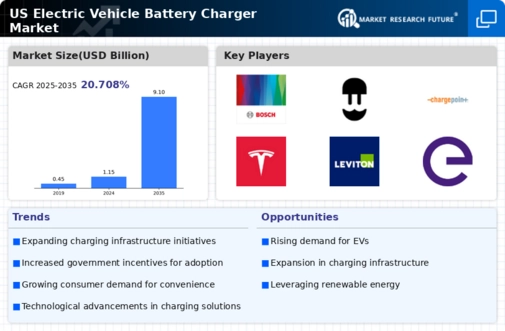The electric vehicle-battery-charger market is currently characterized by intense competition and rapid innovation, driven by increasing consumer demand for sustainable transportation solutions. Key players such as Tesla (US), ChargePoint (US), and Electrify America (US) are at the forefront, each adopting distinct strategies to enhance their market positioning. Tesla (US) continues to leverage its strong brand equity and technological prowess, focusing on expanding its Supercharger network while investing heavily in battery technology to improve efficiency and reduce costs. ChargePoint (US), on the other hand, emphasizes partnerships with various stakeholders, including municipalities and businesses, to enhance its charging infrastructure across urban areas. Electrify America (US) is also expanding its footprint, particularly in underserved regions, thereby contributing to a more inclusive charging ecosystem. Collectively, these strategies not only intensify competition but also foster a more robust market environment that encourages innovation and collaboration.
In terms of business tactics, companies are increasingly localizing manufacturing and optimizing supply chains to mitigate risks and enhance responsiveness to market demands. The market structure appears moderately fragmented, with a mix of established players and emerging startups vying for market share. This fragmentation allows for diverse offerings and competitive pricing, although the influence of major players remains substantial, shaping industry standards and consumer expectations.
In October 2025, Tesla (US) announced the launch of its new generation of Superchargers, which are designed to reduce charging times by up to 50%. This strategic move is significant as it not only enhances the user experience but also positions Tesla (US) as a leader in charging technology, potentially attracting more customers to its ecosystem. The emphasis on faster charging aligns with consumer preferences for convenience and efficiency, thereby reinforcing Tesla's competitive edge.
In September 2025, ChargePoint (US) unveiled a partnership with a major retail chain to install charging stations at over 1,000 locations nationwide. This initiative is crucial as it expands ChargePoint's network and accessibility, catering to the growing number of electric vehicle users. By integrating charging solutions into everyday locations, ChargePoint (US) is likely to enhance customer convenience and drive higher utilization rates of its charging stations.
In August 2025, Electrify America (US) launched a new initiative aimed at increasing the availability of ultra-fast charging stations in rural areas. This strategic action is particularly important as it addresses the charging infrastructure gap in less populated regions, promoting wider adoption of electric vehicles. By focusing on underserved markets, Electrify America (US) not only enhances its market presence but also contributes to the overall growth of the electric vehicle ecosystem.
As of November 2025, current trends in the electric vehicle-battery-charger market indicate a strong shift towards digitalization, sustainability, and the integration of artificial intelligence in operations. Strategic alliances among key players are increasingly shaping the competitive landscape, fostering innovation and enhancing service offerings. Looking ahead, competitive differentiation is likely to evolve from traditional price-based competition to a focus on technological advancements, supply chain reliability, and customer-centric solutions. This shift underscores the importance of innovation as a key driver of success in the electric vehicle-battery-charger market.






















Leave a Comment